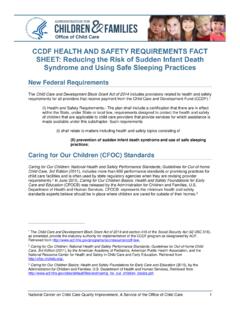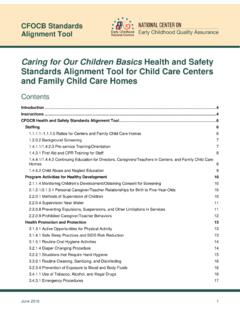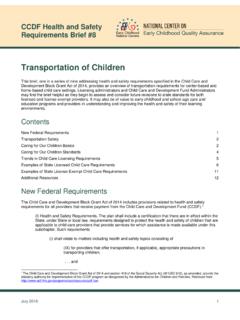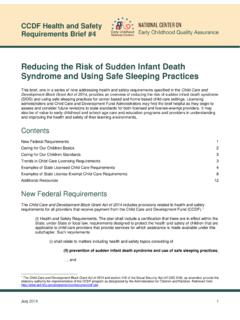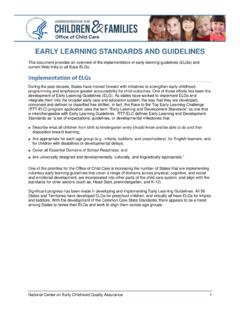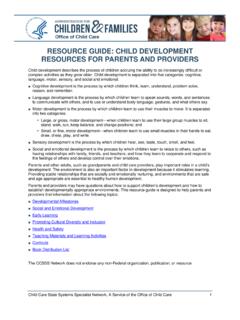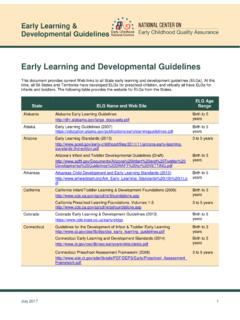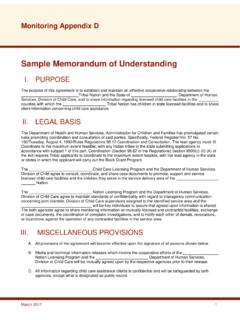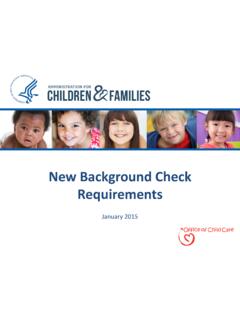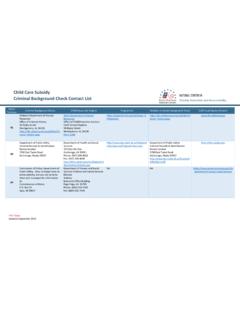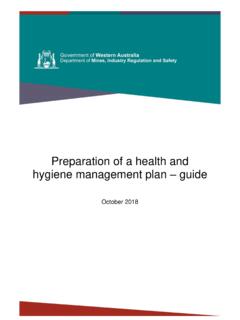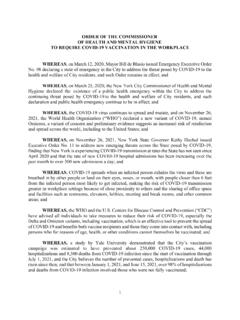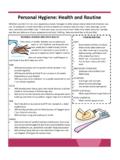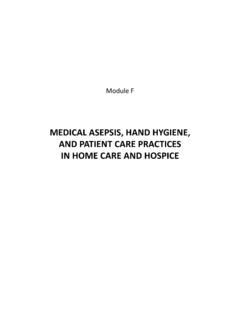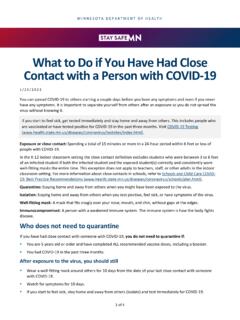Transcription of Prevention and Control of Infectious Diseases
1 CCDF health and Safety Requirements Brief #1 July 2020 1 Prevention and Control of Infectious Diseases The Child Care and Development Block Grant (CCDBG) Act of 20141 and the Child Care and Development Fund (CCDF) Program final rule (2016)2 require states and territories to have health and safety requirements in 11 different topic areas, as well as preservice and ongoing training on those topics, for all providers that receive payments from the CCDF subsidy This brief provides an overview of the Prevention and Control of Infectious Diseases . A series of briefs about CCDF health and safety requirements was first released in July 2016 by the National Center on Early Childhood Quality Assurance (ECQA Center) in response to the CCDBG Act of 2014. A summary of findings about the topic from the 2017 Child Care Licensing Study is a feature of this July 2020 update to those briefs. Data for the study were compiled from state child care licensing regulations in effect as of December 31, 2017 (ECQA Center, 2020a, 2020b, 2020c).
2 Licensing and CCDF Administrators may find the brief helpful as they consider revisions to state standards for both licensed and license-exempt providers. It may also be of value to early childhood and school-age care programs and family child care providers, helping them understand and improve the health and safety of their learning environments. What Are the Basic Requirements? Caring for Our Children Basics: health and Safety Foundation for Early Care and Education (CFOCB) represents the minimum health and safety standards experts believe should be in place where children are cared for outside their homes. The following lists contain CFOCB links to the basic requirements for the Prevention and Control of Infectious Diseases . health Promotion and Protection Situations that Require Hand hygiene Prevention of Exposure to Blood and Bodily Fluids Routine Cleaning, Sanitizing, and Disinfecting Inclusion/Exclusion/Dismissal of Children Infectious disease Outbreak Control Infectious Diseases Immunization Documentation 1 42 9858c(c)(2)(I) (2015).
3 2 Child Care and Development Fund, 45 (2016). 3 Child Care and Development Fund, 45 (2016). Prevention and Control of Infectious Diseases July 2020 2 Unimmunized Children Immunization of Caregivers/Teachers Best practices, which exceed CCDF requirements, are found in Caring for Our Children: National health and Safety Performance Standards; Guidelines for Early Care and Education Programs, CFOC Standards Online Database (CFOC). You can learn more about best practice recommendations to prevent and Control Infectious Diseases by exploring the following CFOC links: Chapter 3: health Promotion and Protection Chapter : Management of Illness Chapter 7: Infectious Diseases Why Is It Important to Children? Young children are more susceptible to illnesses because their immune systems their bodies natural defenses against disease are not yet built up (Simon, Hollander, & McMichael, 2015). In their first year in a group setting, children at any age tend to get sick more than children who have less contact with other children (Augustine, Crosnoe, & Gordon, 2013).
4 Contaminated hands are the most common means of infection transmission in child care settings (American Academy of Pediatrics, American Public health Association, & National Resource Center for health and Safety in Child Care and Early Education, 2019). Keeping hands clean is one of the most important steps child care providers can take to avoid children and adults getting sick and spreading germs to others. Child care programs can implement a variety of Prevention techniques to reduce the spread of Infectious disease , such as developing policies and protocols for handwashing and sanitation practices. Programs can also develop policies and protocols for how and when to exclude or isolate sick children and handle staff illness. Other precautions include documenting and reporting illness events thoroughly and consistently. And finally, programs need to have policies addressing immunizations (Head Start National Center on health & Healthy Child Care America, ).
5 National surveys document high vaccination coverage among preschool-aged children. This has resulted in historically low levels of most vaccine-preventable Diseases in the United States (Centers for disease Control and Prevention , 2013). However, vaccine-preventable infections still occur among children who are not up to date with recommended vaccines. Routine immunizations at the appropriate age are the best means of protecting children against vaccine-preventable Diseases . Immunization is particularly important for children in child care because preschool-aged children have the highest risk of complications from many vaccine-preventable Diseases . (Centers for disease Control and Prevention , 2020). View the Centers for disease Control and Prevention s 2020 Recommended Vaccinations for Infants and Children (birth through 6 years) Parent-Friendly Version. How Do States Establish Requirements? Key Findings from the 2017 Child Care Licensing Study Findings from the 2017 Child Care Licensing Study, a large-scale research study of child care licensing requirements for child care centers, family child care homes (FCCHs), and group child care homes (GCCHs), show commonly found requirements related to the Prevention and Control of Infectious Diseases (ECQA Center, 2020a, 2020b, 2020c).
6 Percent of states and states refer to data from all 50 states and the District of Columbia. Prevention and Control of Infectious Diseases July 2020 3 More than 60 percent of states require children to have a physical exam to enroll in child care. Nearly all states require children to have immunizations to enroll in child care, but most allow exceptions with a written statement from the family or a physician. Eighty percent of states allow centers to exclude mildly ill children, and about one-third include a list of symptoms that can be used to determine if a child should be sent home. Fewer states have requirements about excluding ill children in FCCH and GCCH settings. More than 90 percent of states require center staff and FCCH and GCCH providers to wash their hands, with nearly all of them specifying times when staff and providers need to wash their hands. Nearly all states require children cared for in child care facilities to wash their hands, especially after using the toilet and before and after eating.
7 Approximately 70 percent of states require center staff or family or group home providers to have a physical exam or provide a health statement from a physician before working with children. More than half of states require staff or providers to have a screening for tuberculosis. Examples of State Licensed Child Care Requirements The following tables provide links to state licensing requirements from Delaware, Washington, Illinois, and Oklahoma that support the Prevention and Control of Infectious Diseases , including immunization requirements. These examples do not include all states that have these requirements but are meant to represent a range of approaches states have taken in their regulations. Links to the full text of state and territory licensing regulations for child care centers, FCCH settings, and GCCH settings are found in the National Database of Child Care Licensing Regulations. Child Care Center Requirements Delaware DELACARE: Regulations for Early Care and Education and School-Age Centers (May 2019) 41.
8 Child health Appraisal 52. Area for Children Who Become Ill 58. Sanitation 59. Hand Washing 60. Standard Precautions 62. Child health Exclusions Washington Chapter 110-300, Washington Administrative Code, Foundational Quality Standards for Early Learning Programs (November 2019) 110-300-0200 Handwashing and hand sanitizer. 110-300-0205 Child, staff, and household member illness. 110-300-0210 Immunizations and exempt children. Prevention and Control of Infectious Diseases July 2020 4 Family Child Care Home Requirements Illinois Part 406 Licensing Standards for Day Care Homes (January 2019) Section health , Medical Care and Safety Oklahoma Licensing Requirements for Family Child Care Homes and Large Child Care Homes (January 2018) Section 90. Child health Section 90a. Immunizations Section 90c. Ill children Section 90d. Cleanliness Examples of State License-Exempt Child Care Requirements States have exemptions in law or regulation that define the types of center-based facilities and home-based providers that are not required to obtain a state license to operate legally.
9 Most states allow some exempt providers to receive CCDF funding. And while exempt providers are not subject to the regulatory requirements set forth by the licensing agency, the CCDF final rule4 requires states and territories to have health and safety requirements in 11 different topic areas for all providers participating in the CCDF subsidy program, as well as preservice and ongoing training on those The following table provides examples from Iowa and West Virginia of requirements for license-exempt programs about the Prevention and Control of Infectious Diseases , including immunizations. These examples do not include all states that have these requirements but are meant to represent a range of approaches states have taken in establishing requirements for license-exempt programs. License-Exempt Child Care Requirements Iowa Chapter 120, Child Care Homes, Iowa Administrative Code (November 2019) 441 (237A)(2)(g) Children s files 441 (237A)(1) Professional development 4 Child Care and Development Fund, 45 (2016).
10 5 Child Care and Development Fund, 45 (2016). Prevention and Control of Infectious Diseases July 2020 5 License-Exempt Child Care Requirements West Virginia Title 78: Legislative Rules Department of health and Human Services, Series 20: Informal and Relative Family Child Care Home Registration Requirements (March 2018) 78-20-9. health , Sanitation, and Nutrition. Where Can I Find More Information? 2017 Child Care Licensing Study The ECQA Center, in partnership with the National Association for Regulatory Administration, has conducted a large-scale research study of child care licensing provider and facility requirements and licensing agency policies every three years since 2005. The 2017 Child Care Licensing Study looks at licensing requirements for child care centers, family child care homes, and group child care homes and licensing agency policies in all 50 states and the District of Columbia for 2017. The ECQA Center (2020a, 2020b, 2020c) released three research briefs about trends in child care licensing that describe changes in licensing requirements and policies by comparing the findings from the 2017 study with findings from previous child care licensing studies.
